‘Must Read’ - Gold & The Changing World Order
News
|
Posted 07/01/2022
|
15695
A bit of a longer one today but it is a critical read if you want to understand the ‘big picture’. This is the macro of macro… Back in 2020 we discussed Ray Dalio’s take on the rise and fall of empires and the long term debt cycles that go with that. So as not to repeat too much today, they are both very much worth reading here and here first. For those who don’t know him, Ray Dalio is the founder and CIO of the world’s largest hedge fund, Bridgewater. Below is a summary of his articles published on LinkedIn this week. If you want to read the full long version, and we recommend you do, here is the link - https://www.linkedin.com/pulse/changing-world-order-new-paradigm-ray-dalio/
Lets start with his conclusion up front and then look at some key charts.
“The world order is changing in important ways that have happened many times before in history, though not in our lifetimes. How the world order is changing has created the paradigm that we are in. By “paradigm,” I mean the environment that we are in. Paradigms typically last about 10 years, with occasional big corrections within them. They are driven by a persistent set of conditions that takes those conditions in a swing from one extreme to an opposite extreme. Because of this, each paradigm is more likely to be opposite than similar to the one before it. For example, the Roaring ’20s were followed by the depressionary 1930s, and the inflationary 1970s were followed by the disinflationary 1980s. The assets and liabilities that you would most like to have, and those that you would most like to avoid, change with the paradigm that exists at the time. For example, in the Roaring ’20s you’d want to own stocks and avoid bonds, while in the depressionary 1930s it would be the opposite; in the inflationary 1970s you’d want to own hard assets like gold and avoid bonds, while in the disinflationary 1980s you’d want to own financial assets and avoid hard assets.
For reasons explained in this report, I believe the current paradigm is a classic one that is characterized by the leading empire (the US) 1) spending a lot more money than it is earning and printing and taxing a lot, 2) having large wealth, values, and political gaps that are leading to significant internal conflict, and 3) being in decline relative to an emerging great power (China). The last time we saw this confluence of events was in the 1930-45 period, though the 1970-80 period was also analogous financially. In this piece, I will explain my reasoning and show charts that display these things happening. (For a much more comprehensive description, read Principles for Dealing with the Changing World Order.)
What should one do in this new paradigm? This paradigm is leading to a big shift in wealth and power. Naturally, as a global macroeconomic investor, the economic and market behaviors in this paradigm are top of mind. I think one should consider minimizing one’s ownership of cash and bonds in dollars, euros, and yen (and/or borrow in these) and putting funds into a highly diversified portfolio of assets, including stocks and inflation-hedge assets, especially in countries with healthy finances and well-educated and civil populations that have internal order. These things are especially important in this paradigm. In brief, I think one’s assets and liabilities should be well-balanced with minimum exposures to dollar, euro, and yen currency and debt assets. During this time, I also think it will pay to be short cash (i.e., borrow cash). Of course there will be corrections during the several years in the paradigm—for example, in central bank tightenings. But I don’t see any sustained period in which the government will likely allow cash returns to be better than the returns of a well-diversified, non-cash portfolio (e.g., All Weather) geared to the level of risk you’re comfortable with because that would cause terrible problems. These circumstances also have big geopolitical implications, which I will touch on here.”
Dalio then goes on to address 3 key issues that evolve from this:
1) Big Debt and Debt Monetizations - Particularly in the World’s Leading Reserve Currency
2) Internal Conflicts - over Wealth and Values Gaps
3) External Conflicts - Most Importantly the Rise of a Great Power (China) to Challenge the Existing Great Power (the US)
To summarise each:
1) BIG DEBT AND DEBT MONETIZATIONS
The chart below shows for the US how debt levels (black line) are high today and were high in the 1929-33 and 2008 periods. In both cases, interest rates hit 0% (blue line), and the printing of money and buying of financial assets began in a big way (red line). COVID has seen that exacerbated and likely to continue with a global political move to the left. “This makes everyone financially rich (i.e., they have a lot of money) and devalues money, which takes away much of this newfound wealth.”

Dalio then goes on to graphically show what should already be very apparent to most and that is “cash and bonds are stupid to own” given you are currently getting “the worst interest rates ever in both inflation-adjusted and nominal terms.”
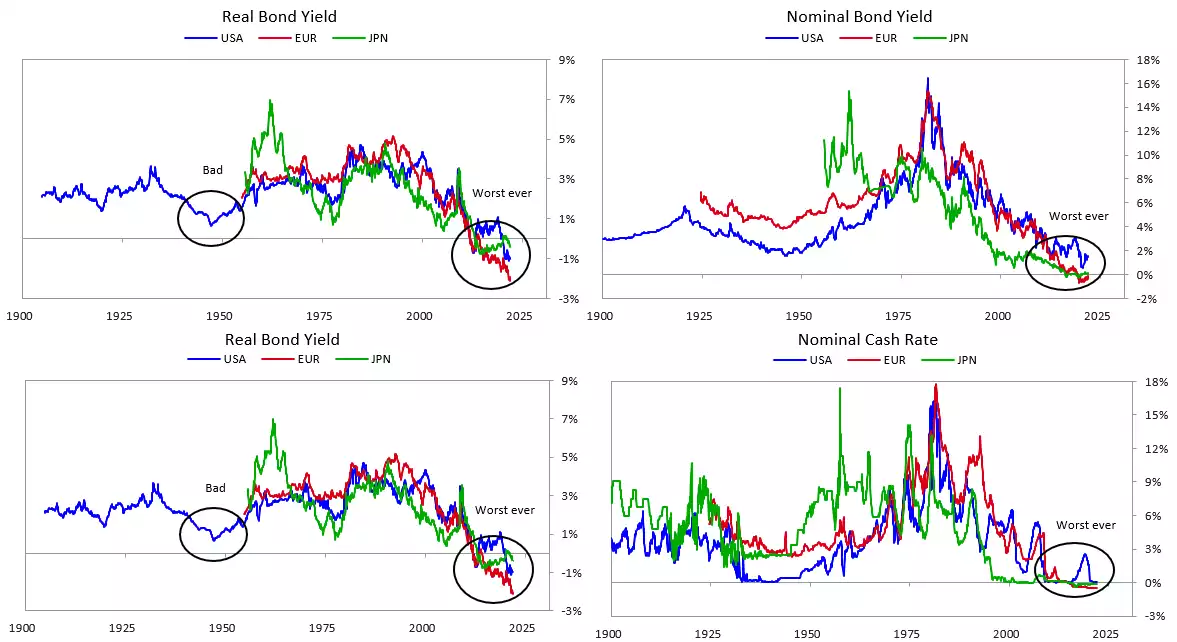
At the time when the Fed is tapering QE and being forced to look at raising rates on surging inflation, Dalio reminds us that “remember that one person’s debts are another person’s assets, and imagine what would happen if the asset holders sold because the debt assets were unattractive (which they are). That would lead to either a big increase in interest rates or a huge increase in the printing of money to buy the debt to artificially hold interest rates down. The chart below shows the amount of debt assets relative to GDP, which means that a lot can be sold if the holders lose their taste for it.”

And here’s the crunch for precious metals investors… “the amount of financial assets relative to real assets is dangerously high, which could lead to a “bank run”-type move from financial assets to real assets….. There is only one purpose of investment assets, and that is to sell them to get cash to buy the real goods and services that one wants. Throughout history, whenever there were far more claims on real assets than there were real assets, a crisis eventually occurred when many holders of these financial assets went to sell them and discovered that there were far too many of them. That led to a “run on the bank”-type dynamic. Right now, there are vastly more financial assets than there are real assets, so if there was a move to convert them into real assets, that would lead to a “run on the bank”-type dynamic, which central banks would certainly respond to by printing a lot of money to allow people to get the money, but it would be of much less value.
Making financial asset prices go up by creating a lot of money and debt makes people financially richer, but it doesn’t make them actually richer. It also leads to periods of bad real returns. This is shown in the following charts. The top chart shows financial asset values as a percentage of all assets, the second chart shows financial net worth relative to GDP, and the third chart shows rolling returns of the 60/40 stock/bond portfolio since 1910.”
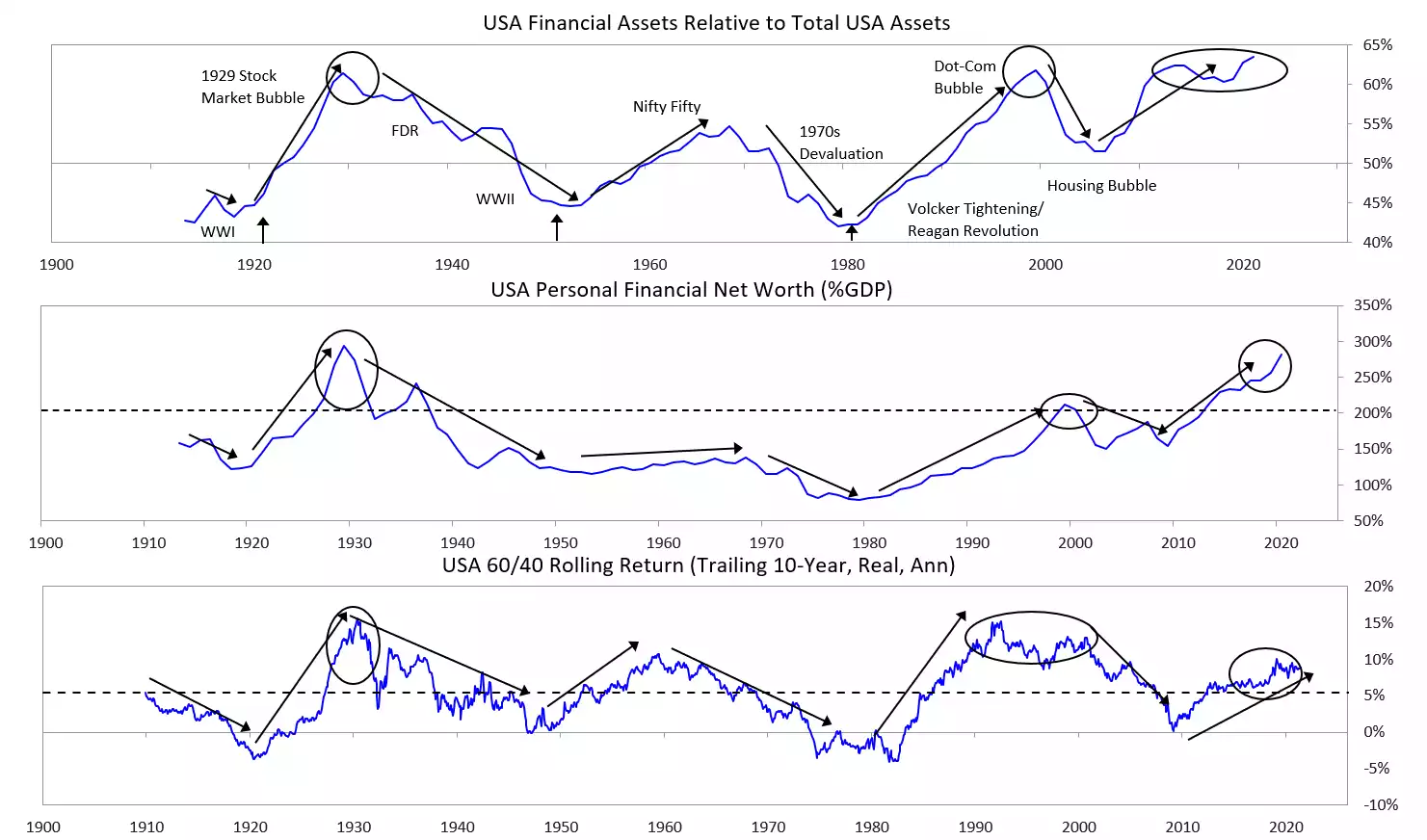
2) INTERNAL CONFLICTS OVER WEALTH AND VALUES GAPS
Again not new to regular readers and covered by Dalio extensively previously. Fundamentally, the fiscal response by central banks has seen an incredible explosion of ‘wealth’ for the rich but left the ‘rest’ behind so that the gap is now the largest since the 1930’s.

The social implications are many and Dalio (in the previous links above) has talked at length to the historic paradigm shifts such deep seated social dislocation fuels. In this piece he presents the growing political divide occurring in the US, greater than “at any time since 1900, so the gap between them is enormous. There is great internal conflict going on in the United States now, which makes it a risky place.”
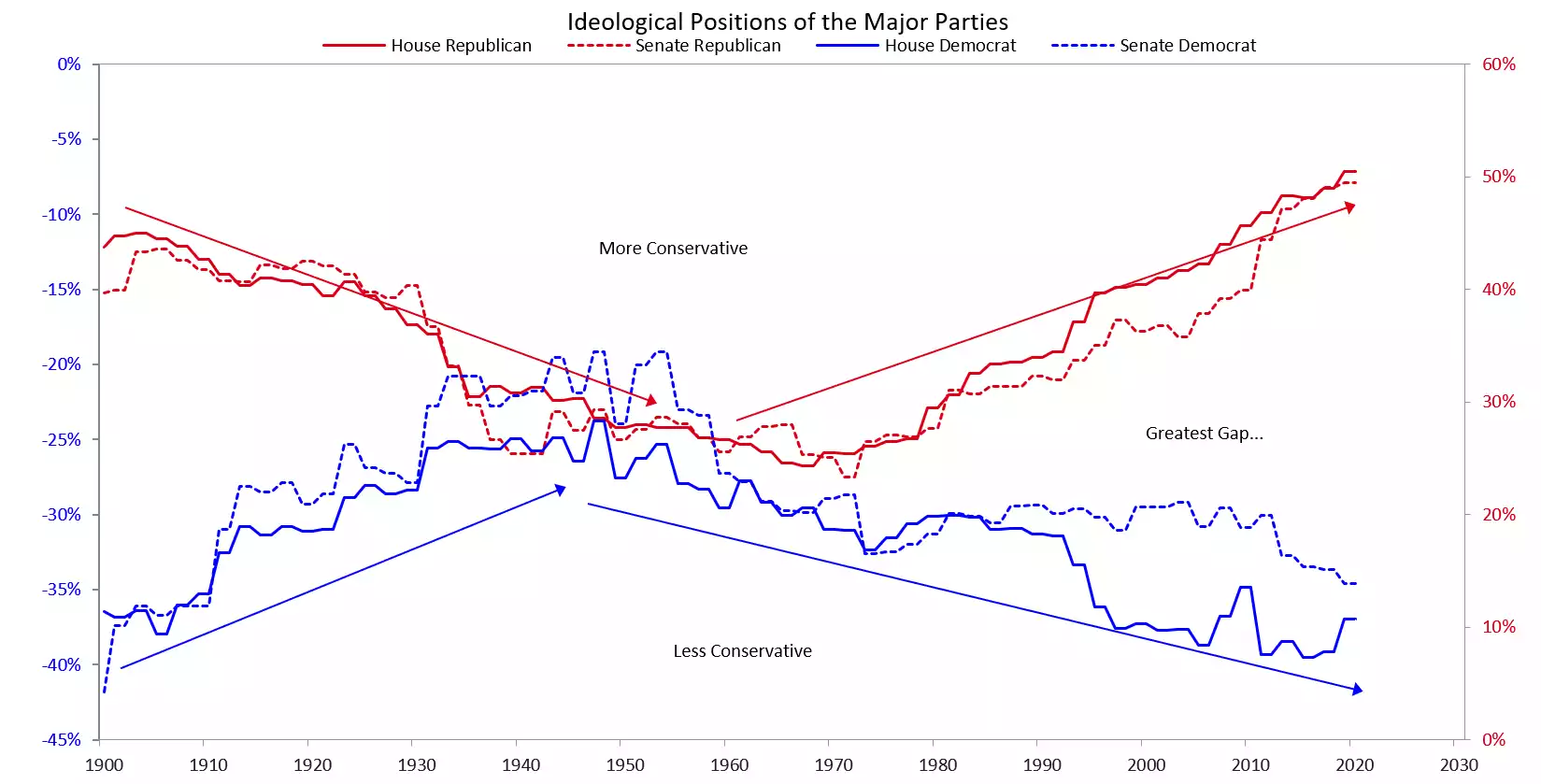
3) EXTERNAL CONFLICTS DUE TO THE RISES AND DECLINES OF GREAT POWERS
Again, covered previously in the links to our previous articles, Dalio believes we are witnessing the transition of dominant empire.
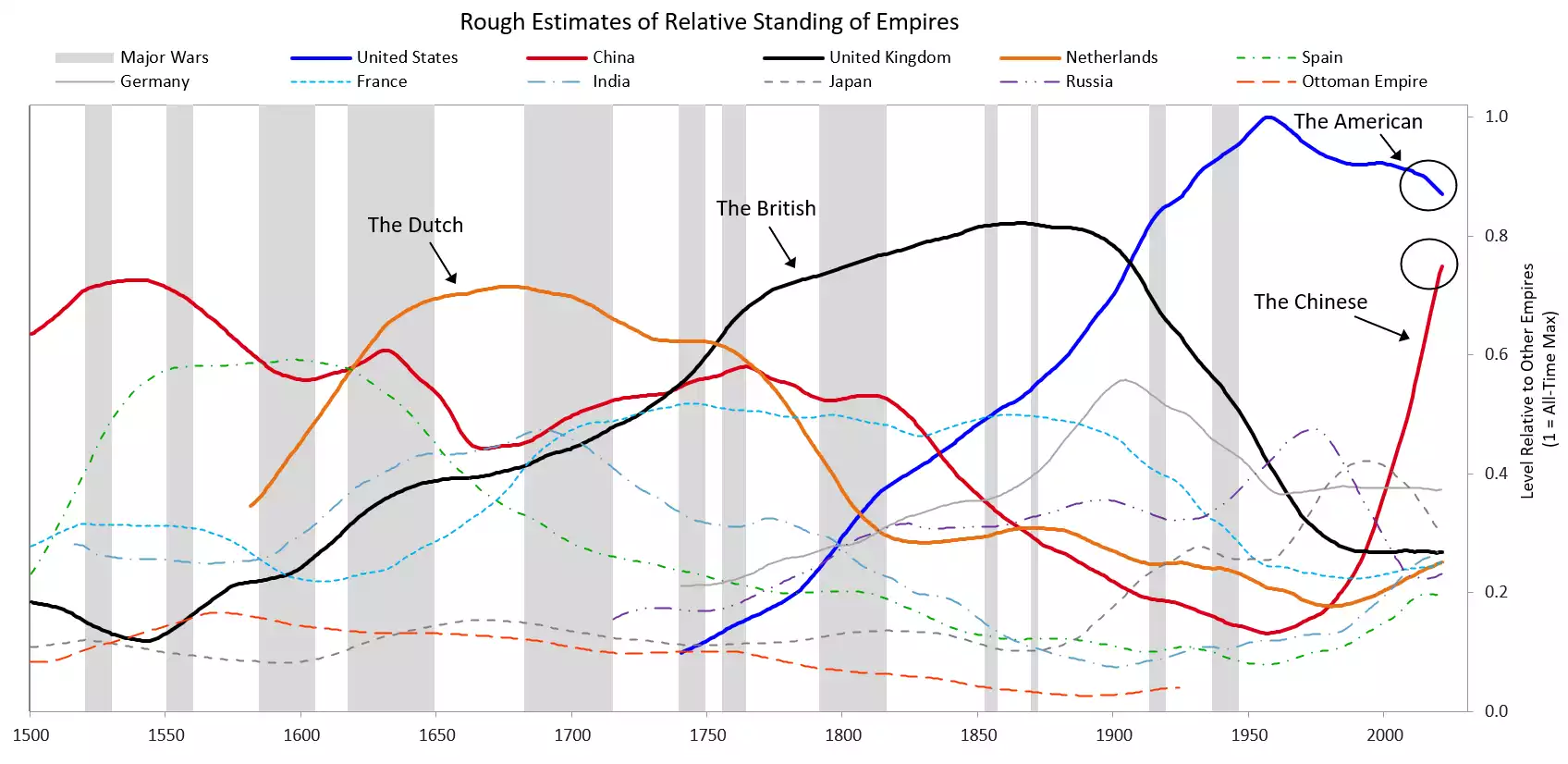
The chart below is “a simplified version of what you just saw for these four empires. The gray shaded areas are the periods of great internal and external conflicts and restructurings via depression, revolution, and war (typically lasting 10-25 years). They are followed by more extended periods of peace and prosperity in which order is brought about by the existence of a dominant power that no country wants to fight because it’s too strong, leading people to work harmoniously together.”

He depicts this cycle insightfully as follows:
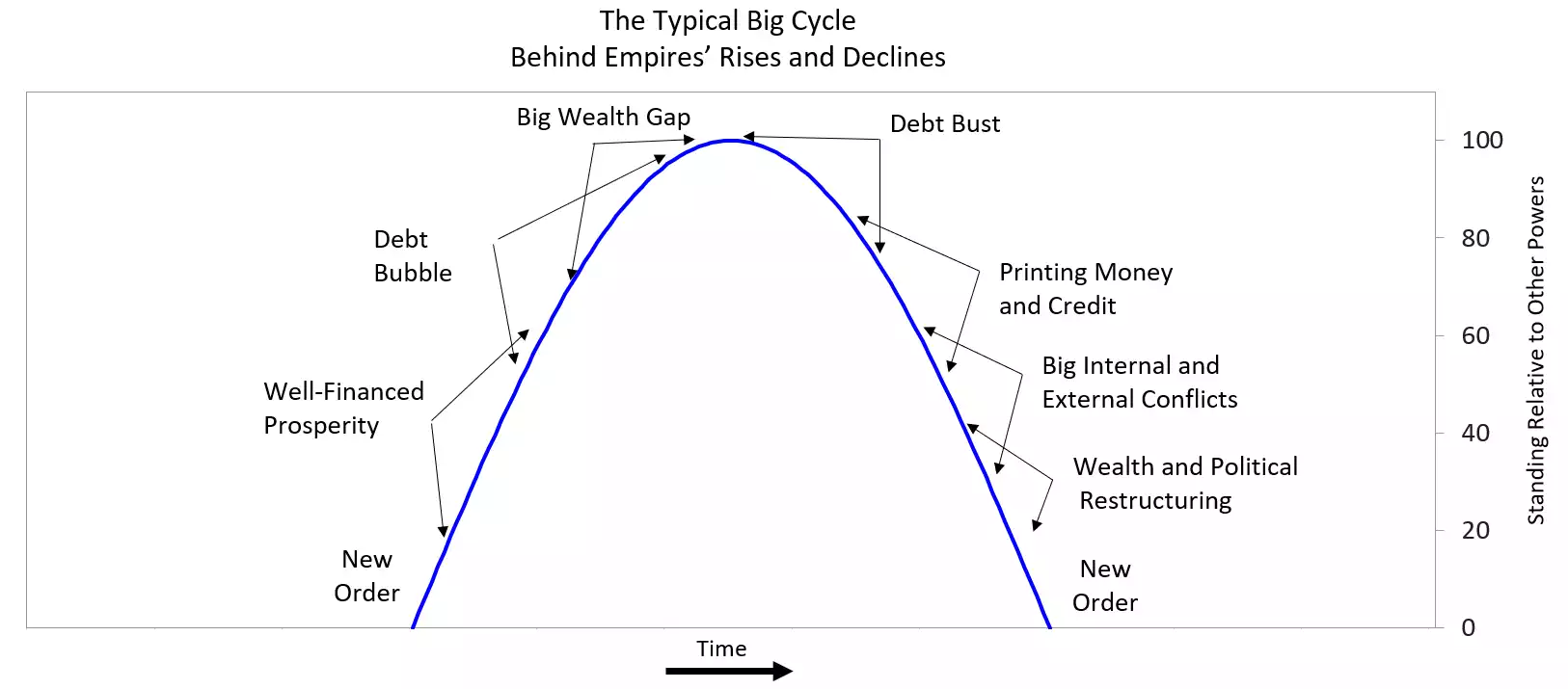
Or in words:
“After revolutions and wars a new order—i.e., a new system run by new leaders—is created. For example, the last world order to be created came after WWII, in 1945. At that point in the cycle there is a dominant power, and nobody wants to fight the dominant power, so this part of the cycle is typically peaceful and, if managed well, prosperous. It is economically rewarding, which leads people to borrow and bet on it continuing, leading to over-indebtedness. Because economic opportunities are naturally distributed unevenly, large wealth gaps develop. Also, with time, competitors emerge and grow in power. Over-indebtedness and declining competitiveness eventually lead to financial problems at the same time as there are large wealth and political gaps. This produces more internal conflict and people demanding more money, which leads governments to create more debt and print a lot more money, which weakens the currency and raises inflation. As the dominant power weakens and other powers get strong enough to challenge it, there are greater internal and external conflicts that lead to revolutionary changes in who has what wealth and power. That ends the old order and leads to the next new order. That is now happening.”
From an investor point of view, his key takeaway is “I believe that important wealth and power shifts are underway, creating a new paradigm in which 1) it is undesirable to hold dollar-, euro-, and yen-denominated credit assets, especially short-term debt assets [cash and bonds], because they will have significantly negative real returns, and 2) it is desirable to hold a well-diversified portfolio of currencies, countries, and asset classes.”
We constantly preach balance and diversification and at a very fundamental, very compellingly obvious level, Dalio highlights overtly the importance of real hard assets in that mix. We often talk about what happens when the $300 trillion of financial assets tries to get into the $1.5 trillion investible gold space. Gold supply cannot simply be expanded and so when that demand hits that finite supply, that only leaves price to change.